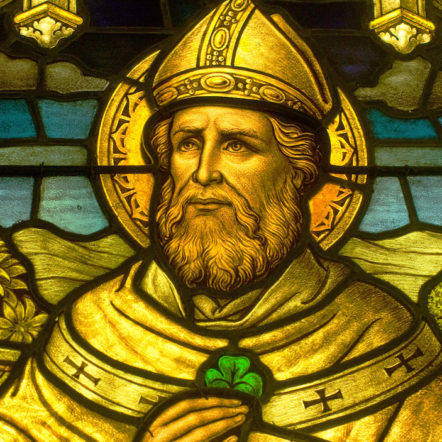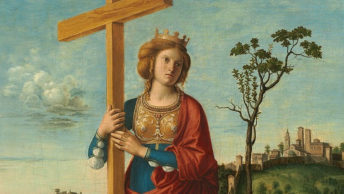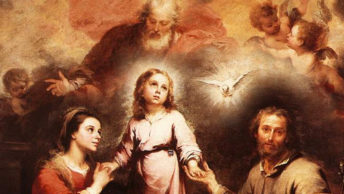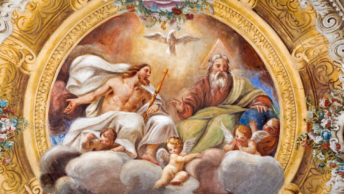Once a priest was in an airport, waiting for his flight to be called; as sometimes happens, a stranger came up and began sharing his opinions on religion. The man boasted, “I won’t accept anything I can’t understand. For instance, take this business of the Three Persons in One God. It doesn’t make sense, no one can explain it to me, and I won’t believe it.” In response, the priest pointed to the sunlight coming in through the window and asked, “Do you believe in the sun?” “Of course I do,” the man answered. “Well,” the priest continued, “the rays which you see come from the sun, some 90 million miles away from here. The heat we feel comes from both the sun and its rays. The Holy Trinity is something like that. The sun represents God the Father, and the rays it sends out represent Jesus, His Son. Together they send out heat, which represents the Holy Spirit. You said that you believe in the sun. Can you explain in scientific terms exactly how the sun and its rays work, and how they produce heat?” The man admitted he couldn’t, and the priest asked, “Then how can you insist on understanding the Holy Trinity before you’ll believe in it?” (Msgr. Arthur Tonne, Five Minute Homilies, Year C, p. 146).
There are people who insist on completely understanding something before they’ll accept it, but we know better; as Catholics, we realize there are certain things beyond our comprehension. In religious terms, we call these things mysteries—and the Holy Trinity is the central mystery of our faith. We can’t explain or understand how there can be Three Persons in One God—but it’s not necessary that we do so. It’s far more important that we allow this truth to affect our lives. The Holy Trinity can provide a model for us as we try to live in grace, fellowship, and love.
Who are the people whose company you most enjoy? The simple and obvious answer is those persons in the world whom you love most deeply. It’s very natural that we desire to be present and united with those whom we love. This link between unity and love especially applies to the Three Persons in the Trinity, Who are perfect love and perfectly united to each Other; it also applies, though in a far less perfect or complete way, to those human persons who love God. Love ultimately leads to unity. Jesus refers to the dogma, or solemn teaching, of the Trinity in the Gospel, for He speaks of God the Father, Who sent the Son for our salvation. Our Lord refers to Himself as God’s equal, for He states that “Everything the Father has is Mine.” Jesus also speaks of the Holy Spirit, Who will guide His followers to the truth. In doing this, the Holy Spirit glorifies Jesus, for all the gifts the Spirit gives come from the Father and through Christ. Thus, we have an example of unity and of cooperating love. Humanity turned away from God through its sinfulness, but—as St. Paul tells us—through Jesus we are now at peace with God the Father, and through the Holy Spirit God’s love has been poured into our hearts.
Because the concept of the Holy Trinity is so abstract, we use different images to express it: the three sides of a triangle forming one geometric pattern, the three leafs of a three-leaf clover, three individual notes forming a musical chord, and so forth. One noted theologian (Hans Urs von Balthasar) uses a different image: he describes the Holy Trinity as an act of speech. Every act of speech consists of a speaker, or person speaking; a word, and the breath that animates the voice and enables the word to be spoken. God the Father is the speaker; God the Son is the Word that’s spoken, and the Holy Spirit is the breath (Thomas J. Scirghi, Longing to See Your Face, p. 37).
Using images like this, we can at least begin to grasp the truth of the reality of the Holy Trinity; the greater challenge is to see how this teaching affects our lives. Doing this might not be as hard at it seems, for the Holy Trinity can be a role model for us in several ways. There’s a saying that “all good things come in threes,” and there are certainly important aspects of life with three parts to them. For instance, we are persons with a past, a present, and a future. Events and decisions from our past helped make us the persons we are now, and practicing virtue and making decisions here in the present helps bring about the glorious future God intends for us.
We can look at the three vows taken by members of religious orders: poverty, chastity, and obedience. Each of these also applies to us in a certain sense. We don’t have to be poor, but we are supposed to be poor in spirit—which means not allowing our possessions to take possession of us, and not placing material things above our faith. We’re called to chastity, which simply means using sex as God intends: as a sacred gift meant only for husband and wife within the traditional form of marriage. Obedience should have meaning for us all: we’re called to obey God’s commandments and to do His will each day.
We can look at the three most important virtues: faith, hope, and love. Faith means our belief in and commitment to Jesus Christ; hope is our conviction that God’s grace is far greater than our sinfulness, and that His strength is greater than our weakness; love is the greatest truth and our most important spiritual duty—love of God and love of neighbor.
All good things come in three. When we look at our lives, we can ask ourselves: Am I like God the Father, the Creator? Do I try to make this a better world, and to be a source of blessing for others? Am I like God the Son, the Redeemer? Do I pray for the conversion and salvation of others, and offer my sufferings for God’s glory? Am I like God the Holy Spirit, the Sanctifier? Do I try to grow in holiness, and to proclaim the truth by my words and example? The Three Persons of the Holy Trinity form a community of grace, of love, and of unity or fellowship. We can’t fully explain this truth—but we can live it by trying, in some small way, to imitate Their example.








